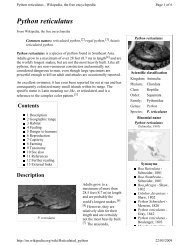Issue Thirteen 30 June 2012 - Taxonomic issue - all - Smuggled.com
Issue Thirteen 30 June 2012 - Taxonomic issue - all - Smuggled.com
Issue Thirteen 30 June 2012 - Taxonomic issue - all - Smuggled.com
Create successful ePaper yourself
Turn your PDF publications into a flip-book with our unique Google optimized e-Paper software.
Hoser <strong>2012</strong> - Australasian Journal of Herpetology 13:55-60.<br />
Australasian Journal of Herpetology 55<br />
Australasian Journal of Herpetology 13:55-60.<br />
Published <strong>30</strong> <strong>June</strong> <strong>2012</strong>.<br />
INTRODUCTION<br />
The Black-striped Snakes are found from the southern United<br />
States through Central America to Peru. Origin<strong>all</strong>y placed in<br />
Coluber, the genus Coniophanes was erected H<strong>all</strong>owell in Cope,<br />
1860.<br />
Various synonyms were used to describe these snakes in the<br />
late 1800’s and early 1900’s including, Tachymenis (now used<br />
for other snakes), Taeniophis (a genus name which was the<br />
same as a genus for fish), Erythrolamprus (now used for other<br />
snakes), Glaphyrophis (now used for other snakes), Homalopsis<br />
(now used for other snakes), Hydrops (now used for other<br />
snakes) and Dromicus (now used for other snakes).<br />
Available online at www.herp.net<br />
Copyright- Kotabi Publishing - All rights reserved<br />
ISSN 1836-5698 (Print)<br />
ISSN 1836-5779 (Online)<br />
A Division of Central American Snake genera,<br />
Coniophanes H<strong>all</strong>owell in Cope, 1860 into six<br />
subgenera and Conophis Peters, 1860 into two<br />
genera (Serpentes: Colubridae: Dipsadinae).<br />
Raymond T. Hoser<br />
488 Park Road, Park Orchards, Victoria, 3134, Australia.<br />
Phone: +61 3 9812 3322 Fax: 9812 3355 E-mail: viper007@live.<strong>com</strong>.au<br />
Received 14 March <strong>2012</strong>, Accepted 15 May <strong>2012</strong>, Published <strong>30</strong> <strong>June</strong> <strong>2012</strong>.<br />
ABSTRACT<br />
The black-striped snakes of North, Central and South America have had a relatively stable<br />
taxonomic history at the genus level. The genus Coniophanes H<strong>all</strong>owell in Cope, 1860 has<br />
been well accepted by herpetologists since being defined.<br />
Notwithstanding this, six divergent and well-defined species groups are known.<br />
To better identify them, six subgenera are erected and defined to ac<strong>com</strong>modate them<br />
according to the Zoological Code.<br />
The available names are Coniophanes for the fissidens species group and Hydrocalamus<br />
Cope, 1885 for the quinquevittatus group.<br />
The four newly named subgenera are, Smythserpens gen.nov., Cottonserpens gen.nov.,<br />
Laidlawserpens gen.nov. and Daraninserpens gen.nov..<br />
Relatively recent studies into the genus Conophis Peters, 1860 has seen species removed<br />
from this genus and placed elsewhere (e.g. Hoge 1958 and Villa 1971). Further to this,<br />
the most divergent member of the genus and type species C. vittatus Peters, 1860 is left<br />
in the genus and the others are placed in a new subgenus Whittonserpens gen. nov..<br />
Keywords: Coniophanes; Conophis; Hydrocalamus; Smythserpens; Cottonserpens;<br />
Laidlawserpens; Daraninserpens; Whittonserpens; new subgenera; taxonomy; snake;<br />
colubrid.<br />
Hydrocalamus Cope, 1885 was barely used by anyone except<br />
Cope himself, but has now been resurrected herein for a<br />
subgenus as indicated below.<br />
The number of described species within what has been gener<strong>all</strong>y<br />
c<strong>all</strong>ed Coniophanes has steadily increased to 17 recognized<br />
forms as of the current date.<br />
Notwithstanding this steady increase in species number, there<br />
have been no attempts for many years to split the genus in any<br />
way, due to several factors, the most obvious being the morphological<br />
similarities of relevant species.<br />
Furthermore a number of major studies published in the latter<br />
part of the 1900’s looked into these snakes and failed to make



